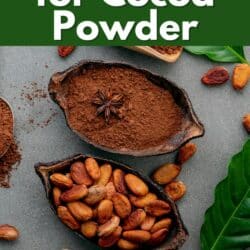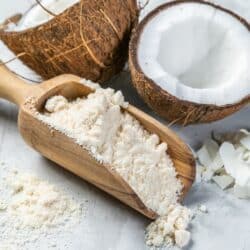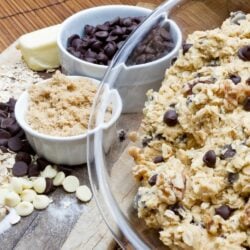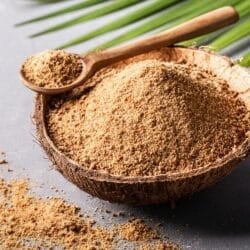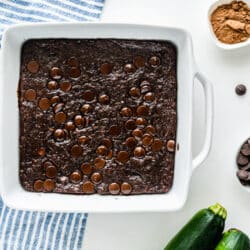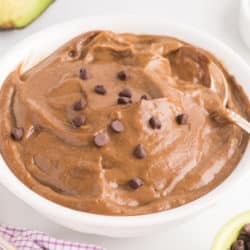5 Easy Substitutes for Cocoa Powder in Baking
Cocoa powder is a key ingredient in many chocolate recipes, but what do you do if you run out or don’t have any on hand? This guide provides some great cocoa powder substitutes including unsweetened baking chocolate, cacao powder, cacao nibs, Nutella, or carob powder.
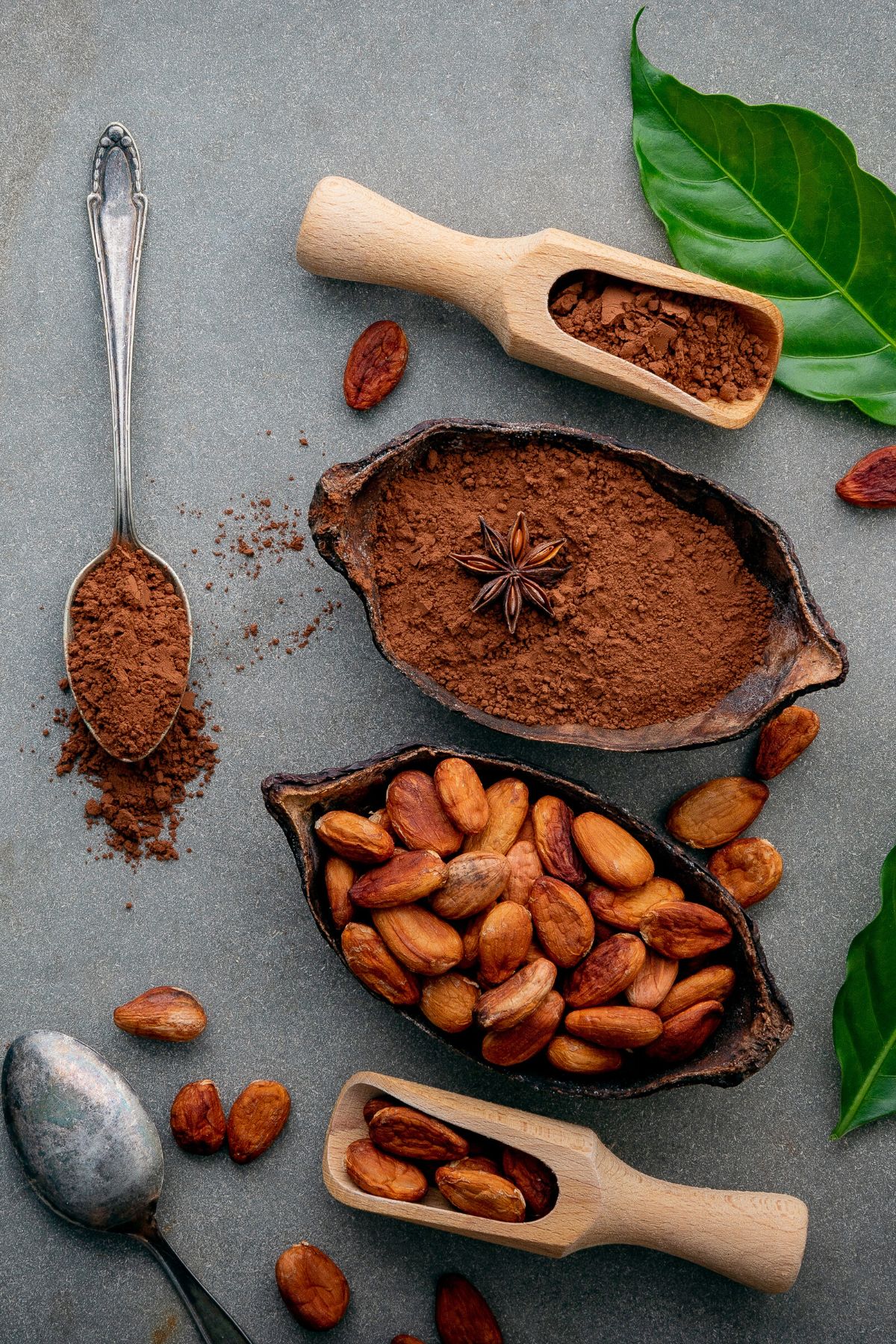
Cocoa powder is made from the beans of the cacao tree.
To produce cocoa, cacao beans are initially fermented and then dried, roasted, and turned into a paste. The cocoa butter is then removed and the resulting mixture is ground into a powder.
Cocoa powder is an unsweetened product. While it tastes like chocolate, it is more bitter than the chocolate bars we are familiar with. This is because it is in its pure form, to which no sweeteners or fats have been added.
Subsequently, it lends a rich, deep flavor, color, and fragrance to chocolate-based desserts and drinks.
It is important not to confuse cocoa powder with chocolate powder, as they are quite different products. Whereas cocoa powder is pure and natural, chocolate powder is processed with other ingredients including milk powder and sweeteners.
Substitutes for Cocoa Powder
But, if you find yourself out of cocoa powder or you need to substitute it for any reason, then here are the some of the best alternatives!
1. Unsweetened baking chocolate
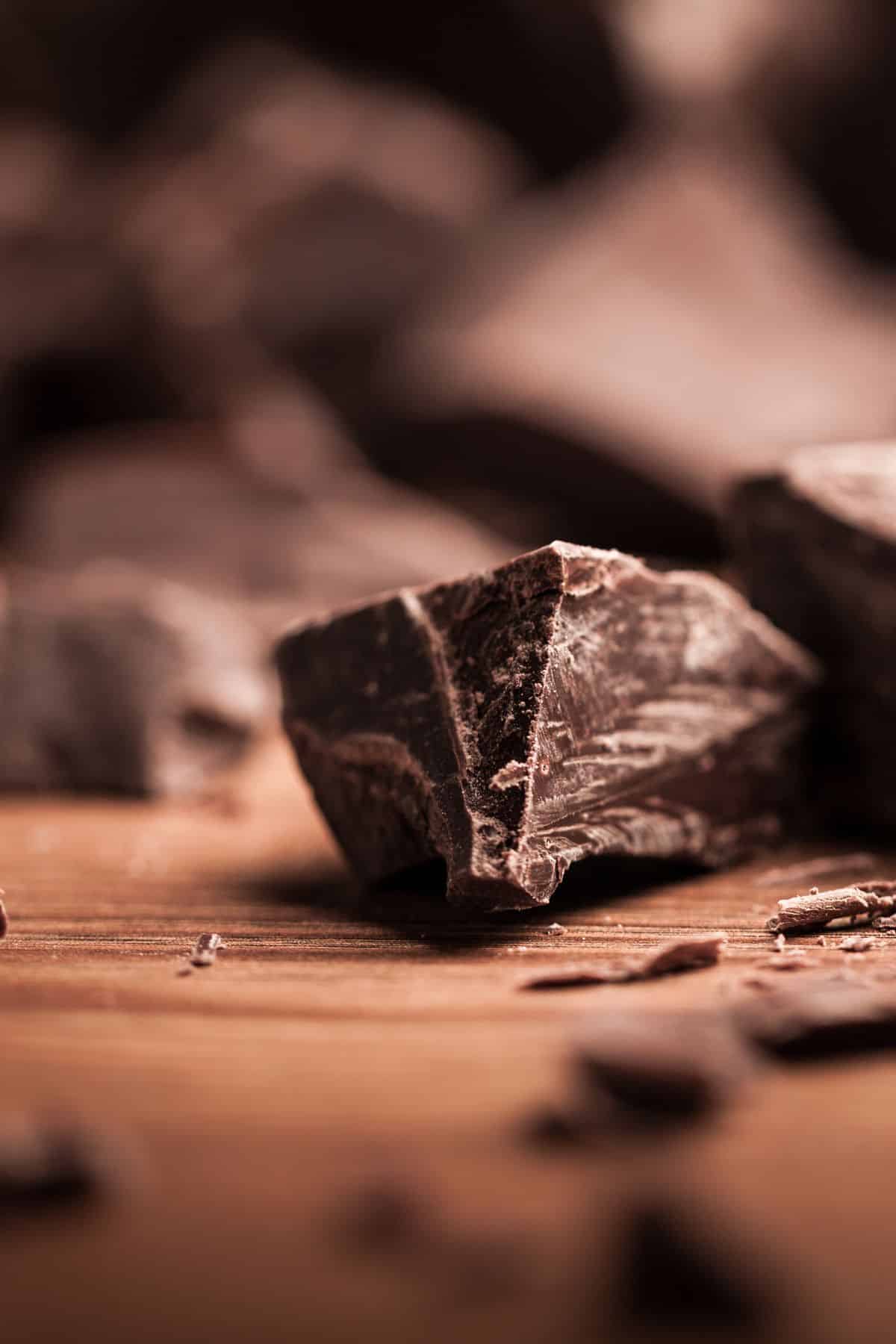
Because unsweetened cooking chocolate has a high content of cocoa solids and chocolate liquor, it will lend plenty of flavor to your recipes. Just like cocoa, it doesn’t contain any sugar, so you won’t need to worry about it affecting the sweetness of your finished dish.
It does, however, contain cocoa butter, so you will need to use less fat in your recipe if you use unsweetened chocolate as a substitute for cocoa powder.
Just weigh the chocolate before you start, then remove 1 tablespoon of fat from your recipe for every ounce of unsweetened baking chocolate that you use.
You will need to melt the chocolate before you use it. The safest way to do this is to warm it in the microwave in 10-second bursts, stirring between each burst. This avoids the scorching that sometimes happens if you melt chocolate in a pan.
Another alternative is to melt the chocolate in a heat-proof bowl set over a pan of simmering water.
For every 3 tablespoons of cocoa powder in your recipe, you will need 1 ounce of unsweetened baking chocolate. Remember to reduce the amount of fat you use when you use this substitute.
2. Cacao powder
Cacao powder and cocoa powder are made from the same base ingredient – and the words even look alike – but cocoa and cacao are actually two different things!
Cacao powder is made by grinding the whole cacao pod and beans.
Although a little processing is involved, it is done at such a low temperature that cacao is considered to be a raw product.
Subsequently, it is higher in antioxidants but tastes significantly more bitter than cocoa powder. So while you can use it as an alternative to cocoa in your recipes, you may need to add some extra sweetener or a bit of sugar to offset that bitter taste.
On the other hand, some people find cacao powder even nicer than cocoa powder in recipes where sweetness isn’t required, such as in chili or barbecue rubs.
For every 1 tablespoon of cocoa powder in your recipe, you will need 1 tablespoon of cacao powder.
3. Cacao nibs
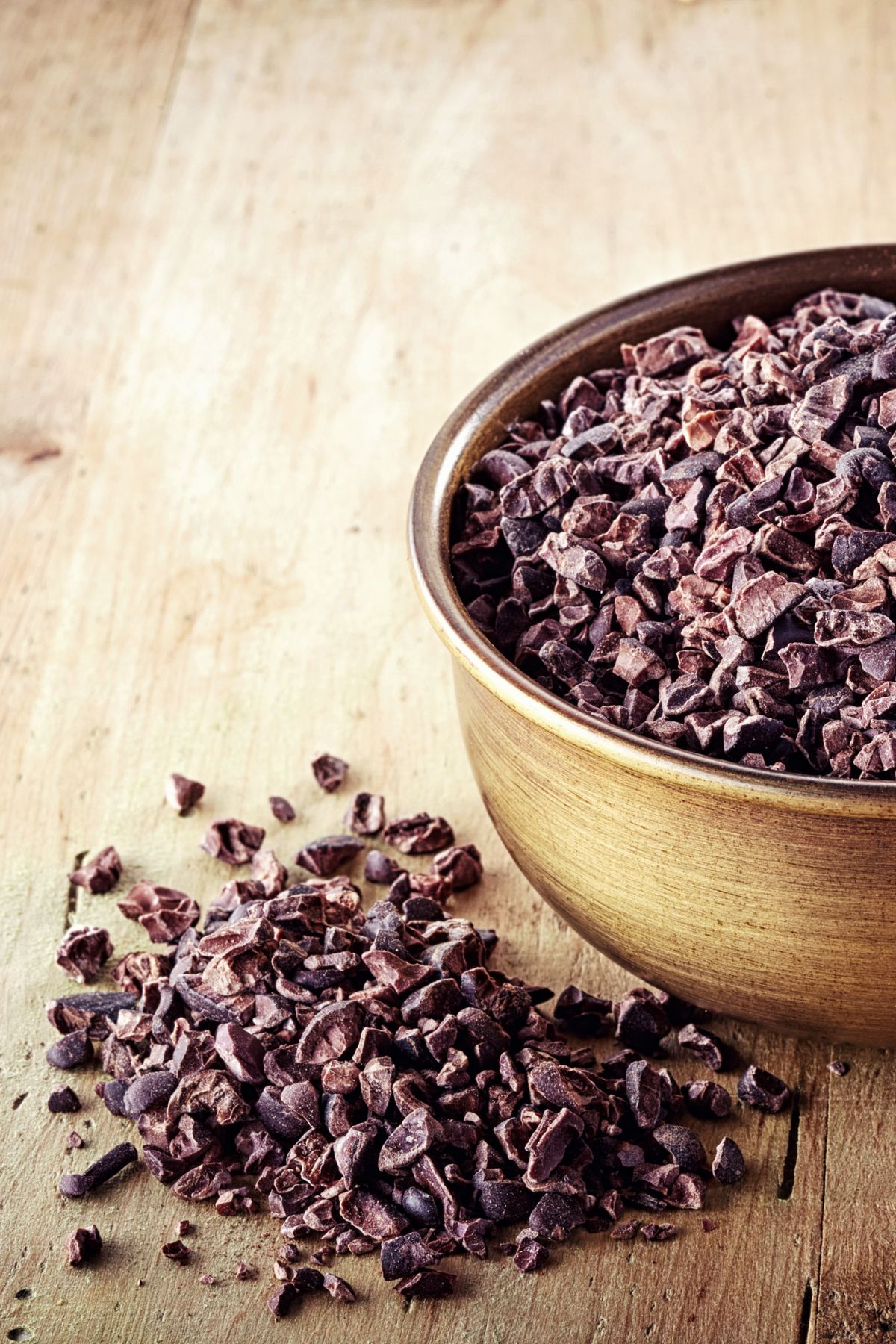
Just like cacao powder, cacao nibs – crushed bits of cacao beans – are nutritious. You can find them sold either raw or roasted, with the raw variety richer in antioxidants.
Similar to cacao powder, they add a rich chocolate flavor to dishes, but no sweetness. In nib form, they also provide a soft, crunchy texture.
However, if you are using cacao nibs as a replacement for cocoa powder, this is unlikely to be the texture you will want, so you will need to grind them into a powder. You can do this using a good food processor or a coffee grinder.
The exception would be if you decided to use them in a mole-style sauce, in which case you could add them whole and then blend the mixture at the end.
For every 1 tablespoon of cocoa powder in your recipe, you will need 1 tablespoon of ground cacao nibs.
4. Nutella
This hazelnut spread made with cocoa powder and sugar is a good substitute for regular cocoa powder in certain dishes.
Because it is so sweet, you will need to reduce the amount of sugar in your recipe. It also contains around 15g of fat per tablespoon, so you will need to reduce the amount of fat in the dish until you reach the consistency you want.
Did you know that it is actually easy to make your own version of Nutella at home? All you need is a blender powerful enough to pulverize the nuts!
Here is a recipe to try:
- 8 ounces roasted hazelnuts (skinless)
- 1 cup confectioner’s sugar
- 1/3 cup unsweetened cocoa powder
- 2 tablespoons coconut oil
- 1 teaspoon salt
- 1 teaspoon vanilla
- Process the nuts in a food processor until finely ground, scraping down the sides as necessary.
- Add the confectioner’s sugar and cocoa and continue to process for about 5 minutes, until thoroughly combined.
- Whilst the food processor is running, drizzle in the coconut oil, vanilla, and salt.
- When the mixture is completely smooth, transfer to a clean jar and store in the fridge for up to one month.
For every 3 tablespoons of cocoa powder in your recipe, you will need 4 ounces of Nutella. Remember to reduce the amount of sugar you use if you use this substitute.
5. Carob powder
Carob powder comes from the carob tree. Although it looks like cocoa powder, it doesn’t have the same bitter flavor. Nevertheless, it makes a good substitute in a pinch!
Because it tastes a bit sweeter than cocoa powder, use a little less sugar in your recipe when using carob powder as a substitute.
One nice little thing about using carob is that it is caffeine-free. This makes it a great alternative to cocoa powder in your recipes if you are one of those people for whom caffeine triggers headaches or any other discomfort.
For every 1 tablespoon of cocoa powder in your recipe, you will need 1 teaspoon of carob powder.
The flavor of your recipe will probably be slightly altered if you use carob instead of cocoa. You can compensate for this flavor difference by reducing the amount of sugar you use.
Summary of Using Cocoa Powder Substitutes
Here’s a summary of the pros and cons of each of the cocoa powder alternatives.
| Substitute | Pros | Cons |
|---|---|---|
| Unsweetened Baking Chocolate | Rich chocolate flavor, contains no sugar. | Contains cocoa butter; requires reduction in other fats in the recipe, needs to be melted before use. |
| Cacao Powder | Higher in antioxidants, can replace cocoa powder directly. | More bitter than cocoa powder, may require additional sweetener. |
| Cacao Nibs | Nutritious, can add a rich chocolate flavor. | Must be ground to a powder for most uses, lacks sweetness. |
| Nutella | Sweet and creamy, adds richness. | High in sugar and fat, adjustments needed for sugar and fat content in recipes. |
| Carob Powder | Sweeter than cocoa, caffeine-free. | Different flavor profile from cocoa, might not be suitable for all chocolate recipes. |
Different Types of Cocoa Powder Available
You’ll find cocoa powder available in stores in several different forms.
Natural cocoa powder
This is the type you’ll see most often. Also known as “pure cocoa powder” or “unsweetened cocoa powder”, it is “natural” because it has not undergone any processing, besides being roasted and having the cocoa butter removed before it was ground into a powder.
Light brown in color, it tastes quite bitter in flavor. With a pH level between 5.3 and 5.8, it is also quite acidic. It is this property that makes it a useful ingredient where leavening is required, as it reacts with baking soda to provide lift.
Dutch-processed cocoa powder
This has undergone a process called “Dutching”, where the cocoa beans are soaked in an alkaline potassium solution. For this reason, the packaging may be labeled “processed with alkali” or “alkalized cocoa powder”.
This dark brown cocoa powder has a neutral PH, so it is much milder in flavor. However, this process reduces the antioxidant content of the cocoa powder. It also makes it unsuitable for recipes that need some degree of leavening.
Black cocoa powder
You will occasionally come across black cocoa powder, which is actually another style of Dutch-process cocoa powder.
Because it is heavily and repeatedly processed, it has a very dark color. To give you an idea of how dark, this is the type of cocoa powder used in Oreo cookies.
Like any other Dutch-process cocoa, it is not ideal for recipes where leavening is required, such as making a cake.
Cocoa mix
Cocoa mix is not actually a proper form of cocoa at all, and shouldn’t be confused with “pure” cocoa as it is far less nutritious.
Hot cocoa mix is designed to quickly make a mug of cocoa when combined with hot water or milk. It is generally sold in packets and contains many other ingredients besides cocoa, often including sugar and milk powder.
It doesn’t provide any of the richness or depth of flavor that natural cocoa powder does when used in baked goods and can’t be used as a substitute.
Some Delicious Recipes Using Cocoa Powder
- Chocolate Peanut Butter Banana Ice Cream
- Vegan Fudgesicles
- Edible Chocolate Cookie Dough
- Chocolate Smoothie Bowl
- Avocado Chocolate Ice Cream
More Articles About Substituting Ingredients
Conclusions
Cocoa powder is a nutritious ingredient that is versatile and full of flavor. Fortunately, there are several other tasty and healthy ingredients that you can use in its place, some of which bring their own unique properties to a dish!
Experiment with different cocoa substitutes to see what gives the best results for your recipe. You may find that one works better than another depending on the dish you’re creating!
Don’t forget to join my newsletter list to get exclusive clean eating recipes and tips. The newsletter is 100% free with no spam; unsubscribe anytime.
About the Author: Carrie Forrest has a master’s degree in public health with a specialty in nutrition and is a certified holistic nutritionist. She is a top wellness and food blogger with over 5 million annual visitors to her site. Carrie has an incredible story of recovery from chronic illness and is passionate about helping other women transform their health. Send her a message through her contact form.


